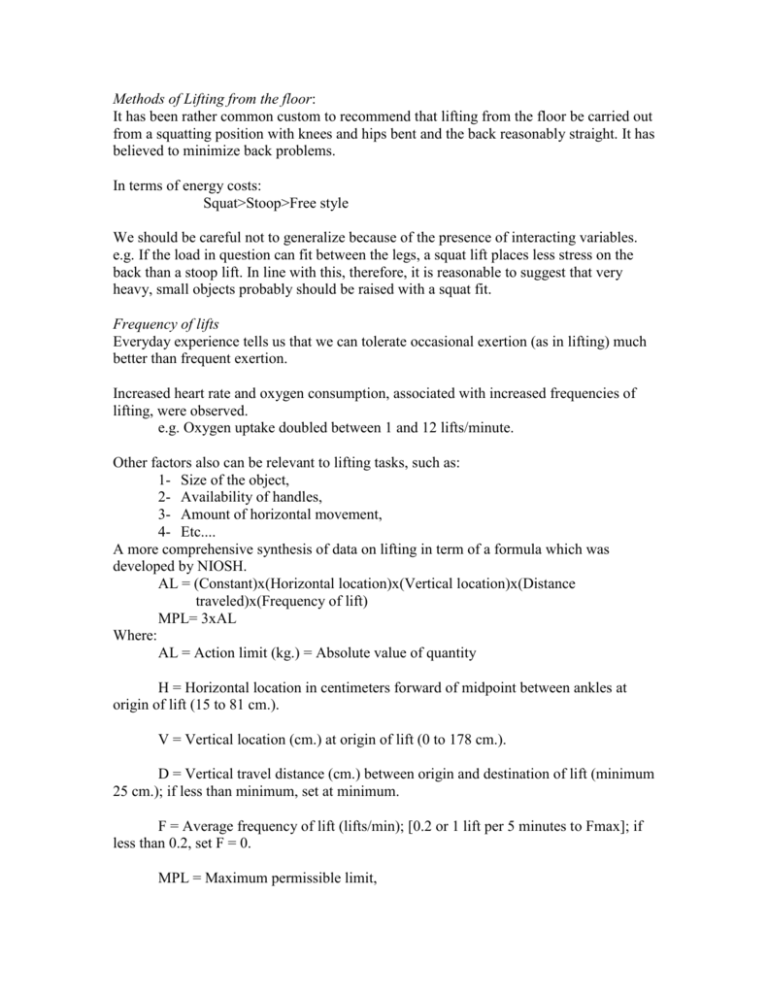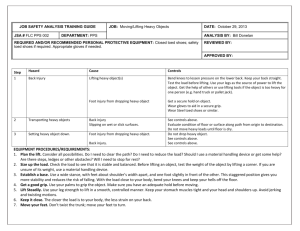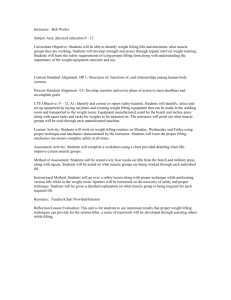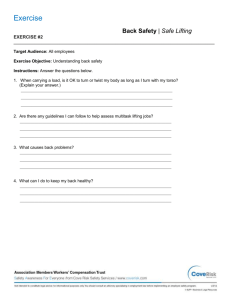Methods of Lifting from the floor - Industrial Engineering Department
advertisement

Methods of Lifting from the floor: It has been rather common custom to recommend that lifting from the floor be carried out from a squatting position with knees and hips bent and the back reasonably straight. It has believed to minimize back problems. In terms of energy costs: Squat>Stoop>Free style We should be careful not to generalize because of the presence of interacting variables. e.g. If the load in question can fit between the legs, a squat lift places less stress on the back than a stoop lift. In line with this, therefore, it is reasonable to suggest that very heavy, small objects probably should be raised with a squat fit. Frequency of lifts Everyday experience tells us that we can tolerate occasional exertion (as in lifting) much better than frequent exertion. Increased heart rate and oxygen consumption, associated with increased frequencies of lifting, were observed. e.g. Oxygen uptake doubled between 1 and 12 lifts/minute. Other factors also can be relevant to lifting tasks, such as: 1- Size of the object, 2- Availability of handles, 3- Amount of horizontal movement, 4- Etc.... A more comprehensive synthesis of data on lifting in term of a formula which was developed by NIOSH. AL = (Constant)x(Horizontal location)x(Vertical location)x(Distance traveled)x(Frequency of lift) MPL= 3xAL Where: AL = Action limit (kg.) = Absolute value of quantity H = Horizontal location in centimeters forward of midpoint between ankles at origin of lift (15 to 81 cm.). V = Vertical location (cm.) at origin of lift (0 to 178 cm.). D = Vertical travel distance (cm.) between origin and destination of lift (minimum 25 cm.); if less than minimum, set at minimum. F = Average frequency of lift (lifts/min); [0.2 or 1 lift per 5 minutes to Fmax]; if less than 0.2, set F = 0. MPL = Maximum permissible limit, Fmax = Maximum frequency which can be sustained, taken from following charts Average Vertical Location > 75 cm. ≤ 75 cm. Period of Performance 1 hour or less More or less continuous during the shift 18 15 15 12 Where: Horizontal location = 15/H Vertical location = 1-(0.004 x│V-75│) Distance traveled = 0.7 + (7.5/D) Frequency of lift = 1 – (F/Fmax) Constant = 40 Conditions for lifting: If weight of the object ≤ AL → Acceptable lifting. If MPL > weight of the object > AL → Administrative control is required. If weight of the object > MPL → Hazardous lifting conditions. If the lifting tasks are found to be very demanding, two basic strategies are possible: 1- Modify the task, 2- Provide rest periods. Example: A cubic compact load, with sides of 40 cm each, is located 15 cm away from the body of an operator. He should grip this load, which is on the floor, and lift it up to a shelf which is around 110 cm heigh from the floor. The frequency of lifting is around once per 5 minutes during the work shift. If the weight lifted is 15 kg, do you see any risks in this lifting taks? Solution: AL= 40 x [(15/35) x (1-(0.004 x │20-75│) x (0.7 + (7.5/110)) x (1 – (0.2/15))] = 10.14 MPL=10.14 x 3 =30.42 kg →10.14 < 15 < 30.42 →Administrative Controls are required. Carrying tasks The parameters for carrying tasks are: 1- Frequency, 2- Individual differences, 3- Sex. When the load is carried at elbow height, the acceptable weight levels are somewhat lower than when the load is carried at knuckle height.. Pushing tasks The parameters for pushing tasks are: 1- Frequency, 2- Distance pushed, 3- Slight sex differences ( There exist no differences for short distances). Measure of Energy Expenditure Douglas bag Method: 1- Collect expired air in a bag over a specified period. 2- Empty the bag through the meter (volume/time). This should be corrected for standard temperature and pressure to obtain the Ventilation Rate (VE). 3- Analyse the oxygen content for the expired air. 4- Estimate the oxygen consumption as follows: Vo2 = VE x (0.209 – X), Where; Vo2: Oxygen consumption (lt/min). VE: Ventilation Rate (lt/min). X: Oxygen concentration of the expired air. Measure of Local Muscular Activity The muscular forces in response to a work load depend on 1)- Muscles used, 2)- The posture, 3)- Amount of force required to meet task. Example: A person is holding a box with both hands. The box weighs 22 kg and is carried equally with both arms. The box is maintained in front of the body with elbows bent at right angles (90o). Compute the muscular forces required? Elbow moment = 22x0.33 + 1.6x0.17 = 7.53 kg-m We can refine our analysis slightly by considering the work of individual muscles. In this case we will assume that biceps will provide the resisting moment. 1- Sum of all horizontal forces are zero, 2- Sum of all vertical forces are zero, 3- Sum of all moments at a given point are zero. Therefore: -0.06 x F + 1.6 x 0.17 + 22 x 0.33 = 0 F = 125 N From 1 and 2 we get Ry = 104.4 N Force versus posture Available muscular force will depend on postures. The posture determines the initial muscle length and the amount of force that will be used to handle the external force. Electromyography (EMG) Dynamic analysis yields information on the forces and moments to which the body and musculoskeletal system repond. But this analysis is cumbersome and it is of little interest to the practicing Industrial Engineer. Electromyography (EMG) offers a reasonable alternative to dynamic analysis. It is a technique for measuring the tension (forces developed as the muscle is shortened or put to work). Action potential that accompanies muscle tension is measured in terms of microvolts. Monitoring a specific muscle consists of placing a pair of electrodes on the muscle. The signal from electrodes is picked and then conditioned before it is displayed on a meter or chart. Muscle action potential (EMG data) varies as a function of several task, person, and workplace variables. The list of variables include: 1- Posture, 2- Speed, 3- Force (weight handled), 4- Range of motion, 5- Muscle mass used, 6- Work/Rest schedule, 7- Initial muscle length, 8- Individual degree of fitness, 9- Clothing, and 10- Static loading. EMG can be used to express objectively the job muscular loading as a percentage of the monitored muscle maximum. If the computed percentage is less than 30% (or even 40 percent), then we may conclude that the task loading is acceptable. For higher percentages, the task must be examined closely for possible redesign or adjustments. Posture Targeting and Analysis It can be used as a substitute for both dynamic analysis and EMG measurements. Describing the posture of various body segments versus time does provide much information concerning; 1)- Static loading, b)- concentration of job motion, and c)extreme motions and positions of various body joints. This information is very important when a job/work place is evaluated or redesigned. The advantage of posture analysis over other methods is the ease with which the assessment/evaluation can be carried out. Procedures: 1- The person is filmed (videotaped) while performing the job. The person should be filmed from two angles in order to record body segment motions in all planes. Filming should continue until several job cycles are covered. Recordings should be made for a representative sample of the persons assigned to the job being evaluated. 2- The film or videotape is viewed in a systematic manner to sample for the occurences of certain segment positions. A special form should be used for this purpose. The form should be designed to document the various positions, the segment assumes, through the task cycle.





